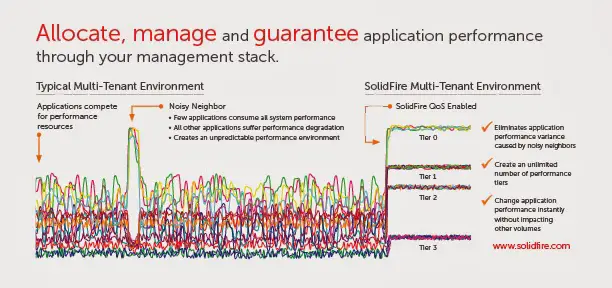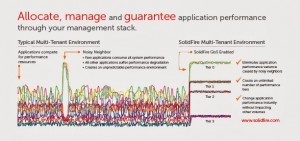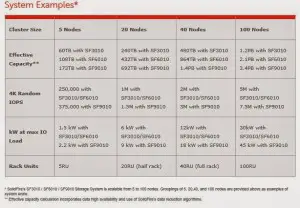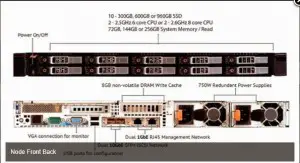I had the chance to meet with the CEO and Founder of SolidFire Dave Wright while at VMworld this year. Who is SolidFire? Well, I will overview that and share a interview I had with Dave shortly.
Solid fire is a all-SSD Architecture platform, that scales and uses raid-less data protection. But if you ask me, what set’s them apart on the SSD arena; I will answer with the QOS.
“Quality of service is not a feature. It is a architecture.” They go in to state it is ” the only way to deliver guaranteed storage performance in public and private cloud infrastructure” source
http://solidfire.com/technology/qos-benchmark-architecture/
The ability to set levels of service is critical in the service provider space. Min, Max and Burst IOPS per volume for example.
As you can see below, the system can really push out the IO the numbers.
As you can see, fairly straight forward on the hardware side, however, I would recommend dedicated switching.
Source http://solidfire.com/technology/solidfire-storage-system/
What else? Add features like a array solutions, VMware , openstack, to name a couple and multitenancy reporting but I won’t touch on this today.
I’ll wrap up with a interview of me personally interviewing Dave, Owner and founder of SolidFire.
My Thoughts?
Need a top tier, with extreme performance? Need QOS? Need multitenancy? There are a Solid reasons to consider SolidFire when looking at Storage. Now if I could get a unit in my lab…
Thanks
Roger Lund
ystem Examples*
| Cluster Size | 5 Nodes | 20 Nodes | 40 Nodes | 100 Nodes |
| Effective Capacity** | 60TB with SF3010 108TB with SF6010 173TB with SF9010 |
240TB with SF3010 432TB with SF6010 692TB with SF9010 |
480TB with SF3010 864TB with SF6010 1.4PB with SF9010 |
1.2PB with SF3010 2.1PB with SF6010 3.4PB with SF9010 |
| 4K Random IOPS | 250,000 with SF3010/SF6010 375,000 with SF9010 |
1M with SF3010/SF6010 1.5M with SF9010 |
2M with SF3010/SF6010 3M with SF9010 |
5M with SF3010/SF6010 7.5M with SF9010 |
| kW at max IO Load | 1.5 kW with SF3010/SF6010 2.2 kW with SF9010 |
6 kW with SF3010/SF6010 9 kW with SF9010 |
12kW with SF3010/SF6010 18 kW with SF9010 |
30kW with SF3010/SF6010 45 kW with SF9010 |
| Rack Units | 5RU | 20RU (half rack) | 40RU (full rack) | 100RU |
– See more at: http://solidfire.com/technology/solidfire-storage-system/#sthash.ccyH5XwR.dpuf
Fine-grain, per-volume settings
SolidFire’s QoS functionality lets cloud providers set and control the fine-grain performance levels for every volume and guarantee application performance with firm SLAs.
- Min IOPS – The minimum number of I/O operations per-second that are always available to the volume, ensuring a guaranteed level of performance even in failure conditions.
- Max IOPS – The maximum number of sustained I/O operations per-second that a volume can process over an extended period of time.
- Burst IOPS – The maximum number of I/O operations per-second that a volume will be allowed to process during a spike in demand, particularly effective for data migration, large file transfers, database checkpoints, and other uneven latency sensitive worklo
– See more at: http://solidfire.com/technology//solidfire-element-os/guaranteed-qos/#sthash.rIuGPn5K.dpuf
Quality of Service is not a feature.
It is an architecture
– See more at: http://solidfire.com/technology/qos-benchmark-architecture/#sthash.aTLD0AKs.dpuf
Quality of Service is not a feature.
It is an architecture.
– See more at: http://solidfire.com/technology/qos-benchmark-architecture/#sthash.aTLD0AKs.dpuf
Quality of Service is not a feature.
It is an architecture.
– See more at: http://solidfire.com/technology/qos-benchmark-architecture/#sthash.aTLD0AKs.dpuf
Quality of Service is not a feature.
It is an architecture.
– See more at: http://solidfire.com/technology/qos-benchmark-architecture/#sthash.aTLD0AKs.dpuf






